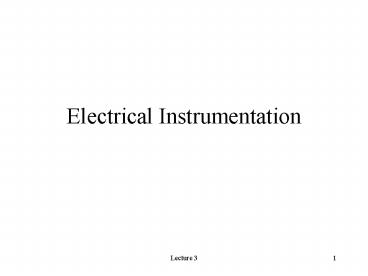Electrical Instrumentation PowerPoint PPT Presentation
1 / 30
Title: Electrical Instrumentation
1
Electrical Instrumentation
2
Electrical Instrumentation
- Electrical instrumentation is the process of
acquiring data about one or more physical
quantities of interest using electrical sensors
and instruments. - This data may be used for diagnostics, analysis,
design, or to control a system.
3
Instrumentation Examples
- Every engineering discipline uses electrical
instrumentation to collect and analyze data. - The following examples are illustrative of the
different types of sensors and instrumentation
that different engineering disciplines use.
4
Strain Measurements
Strain gauge
5
Non-destructive Testing
Ultrasound transducer
6
Automotive Sensors
Oxygen Sensor
Accelerometer
Airflow Sensor
Oil Pressure
Water Temperature
CO Sensor
7
Biomedical
Ultrasound Transducer
8
What other examples can you think of?
9
A Typical Instrumentation System
A/D Converter
Sensor
Computer
10
Instrumentation System
- Sensor-converts the measured value into an
electrically useful value. - Amplifier-conditions the signal from the
sensor. - A/D Converter-converts the signal into a digital
format. - Computer-processes, displays, and records the
signal.
11
Sensor
- The output of a sensor is proportional to the
quantity of interest. - The sensor output may be a
- voltage or current (temperature, pressure)
- resistance (strain gauge)
- frequency (accelerometer)
12
Amplifier
- The output of the amplifier is (usually) a
voltage. - The gain of the amplifier is set so that the
voltage falls between lower and upper limits (for
example, -10V to 10V).
13
A/D Converter
- Analog-to-digital conversion consists of two
operations - Sampling measuring the voltage signal at equally
spaced points in time. - Quantization approximating a voltage using 8 or
16 bits.
14
Instrumentation Issues
- Noise
- Signal bandwidth
- Sampling
- Amplifier characteristics
- Feedback
- Real-time processing
- Control systems
15
Noise
Signal
Signal Noise
16
Sources of Noise
- Thermal noise caused by the random motion of
charged particles in the sensor and the
amplifier. - Electromagnetic noise from electrical equipment
(e.g. computers) or communication devices. - Shot noise from quantum mechanical events.
17
Effects of Noise
- Reduces accuracy and repeatability of
measurements. - Introduces distortion in sound signals.
- Introduces errors in control systems.
18
What to Do?
- How can we eliminate or reduce the undesirable
effects of noise? - Grounding/shielding electrical connections
- Filtering (smoothing)
- Averaging several measurements
19
Signal Bandwidth
- Conceptually, bandwidth is related to the rate at
which a signal changes
Low BW
High BW
20
Bandwidth and Sampling
- A higher bandwidth requires more samples/second
Low BW
High BW
21
Bandwidth Limitations
- Every component in the instrumentation system has
bandwidth limitations - Sensors do not respond immediately to changes in
the environment. - The amplifier output does not change immediately
in response to changes in the input. - The A/D converter sampling rate is limited.
22
Effects of BW Limitations
Sensor Output
Amplifier Output
23
Amplifier Characteristics
- Amplifiers are characterized in terms of
attributes such as - Gain
- Bandwidth and/or frequency response
- Linearity
- Harmonic distortion
- Input and output impedance
24
Op Amps
- One commonly used type of amplifier is the
Operational Amplifier (OpAmp). - Op Amps have differential inputs output voltage
is the amplified difference of two input
voltages. - Op Amps have very large gains (gt103).
25
Op Amps (cont.)
- Most op amp circuits use negative feedback.
- Op amp circuits can be designed to
- Provide voltage gain or attenuation.
- Convert current to voltage.
- Integrate or differentiate.
- Filter out noise or interference.
26
Feedback
- Often, sensors measure quantities associated with
systems. The sensor output is used to control
the system in a desired manner.
27
Example Industrial Process Control
- In many manufacturing processes (integrated
circuits, for examle) temperatures must be
closely controlled. - Feedback can be used to maintain a constant
temperature.
28
Temperature Control
Furnace and Material
Desired Temperature
Control System
Temperature Sensor
- The Control System sets the current supplied to
the heating elements in the furnace to keep the
material temperature at the desired value.
29
A car cruise control is a feedback system. How
does it work?
30
Benefits of Feedback
- Provides stability with respect to changes in
system parameter values. - Helps to obtain a (nearly) linear response from
non-linear components. - Can be used to change the characteristics of a
system under control.

